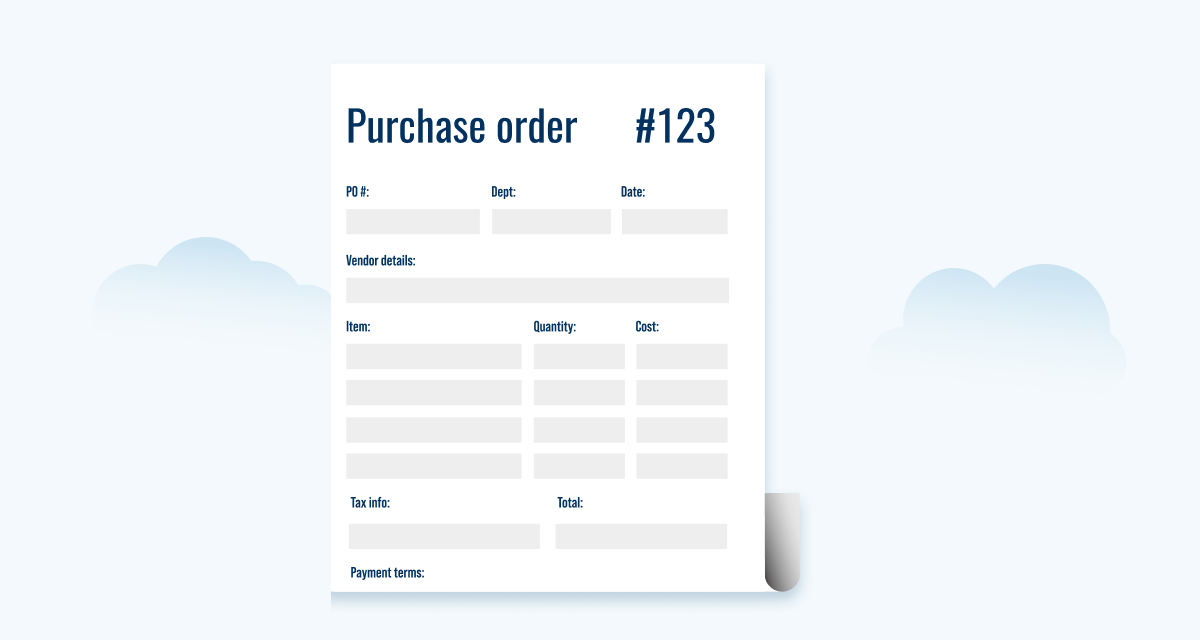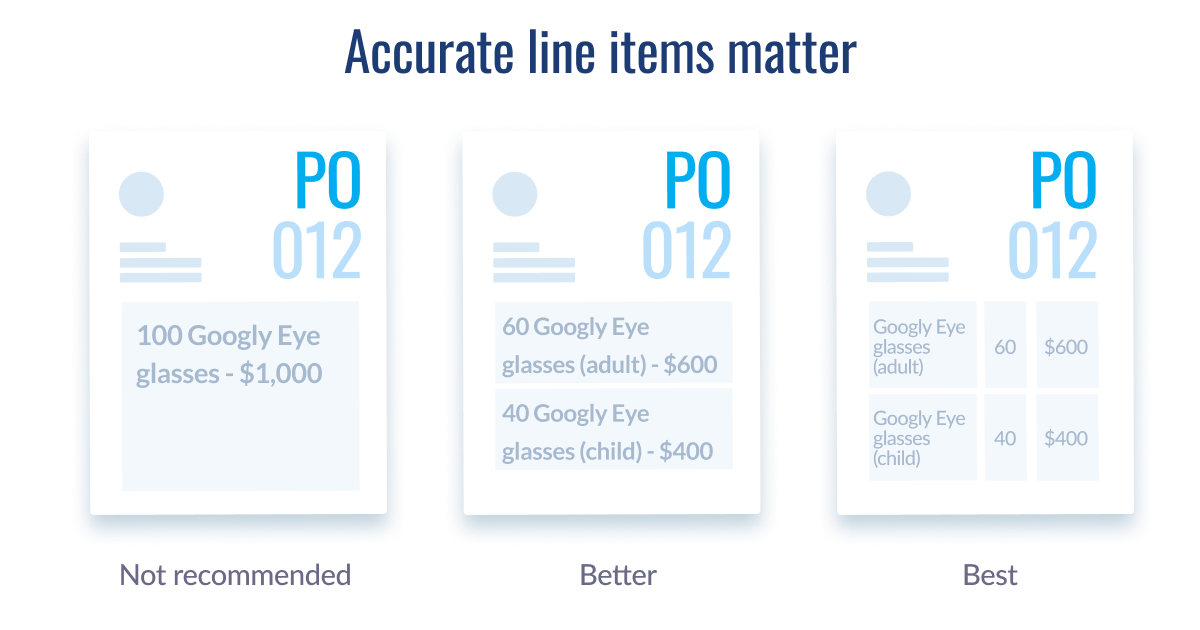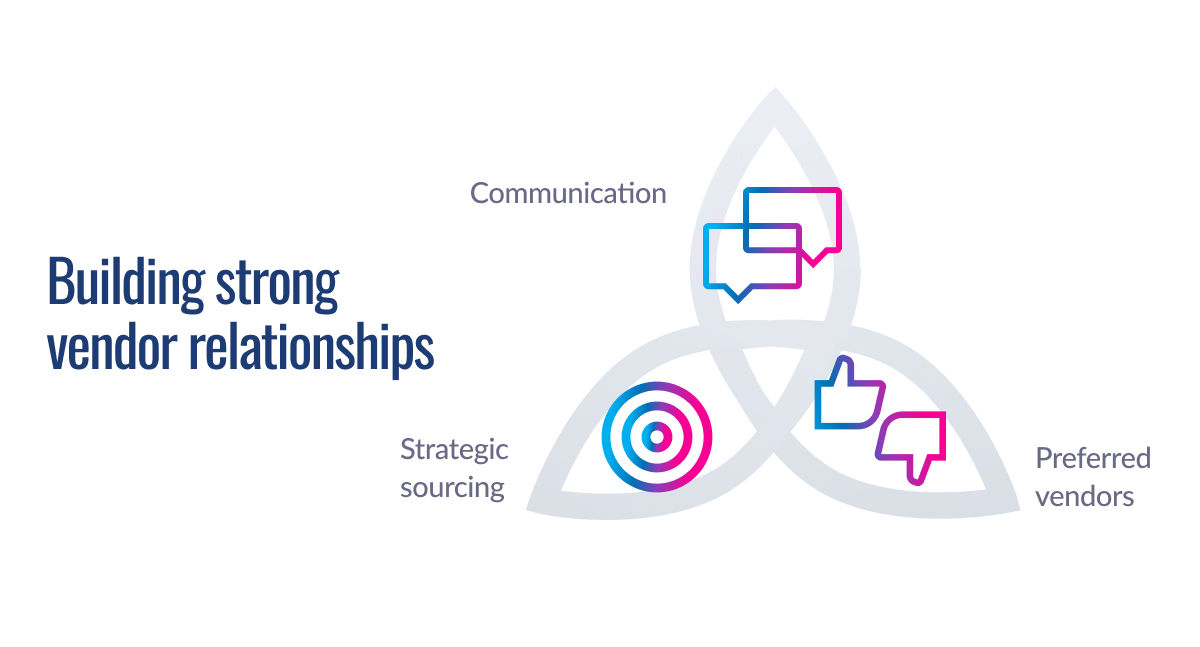The top 3 best practices for effective purchase order management

Improving the purchase order process is a big priority for most finance departments. In Amazon’s 2024 State of Procurement report, 95% of finance leaders said they want to optimize their procurement processes — citing cost reduction, improved standards, and more resilient supply chains as their top goals.
You need an efficient and accurate purchase order management process to reach these goals. When things are working as they should, your organization buys the right goods or services, shipments are accurate, and you pay invoices on time. If there are inefficiencies in your process…you know the story: cost overruns, errors, and delays.
Let’s talk about how you can boost your PO processes. We’ll look at three best practices for creating accurate POs, verifying invoices and POs accurately, and building stronger vendor relationships.
Why are purchase orders so important?
Although they’re not very exciting (except to purchasers), purchase orders are one of the most important documents in procurement. There are two reasons for this:
- Purchase orders are contracts: They’re a legal agreement between a buyer and seller for the purchase and delivery of goods and services. They define the terms of the transaction to keep everyone on the same page (and hopefully prevent legal battles down the road).
- Purchase orders are records: They track the purchase details — including what was bought, who bought it, who they bought it from, and who approved the purchase. An accurate PO record lets you improve spend management and control your cash flow.
POs do a lot, but the main thing is they help you track and control spending. But that only works if they’re accurate. The first best practice shows how to create POs that are complete, correct, and clear.

Best practice 1: Create complete, correct, and clear purchase orders
Purchase orders need to be accurate to be useful. It’s helpful to think of PO accuracy as having three components:
- Completeness: The PO contains all the information necessary for the vendor to fulfill the order and for your team to verify and pay the invoice.
- Correctness: The PO is free from errors, and the order details, vendor information, and payment terms are verified and accurate.
- Clarity: The PO uses clear language, a standardized, logical format, and consistent wording. Special instructions are clearly stated.
Creating complete, correct, and clear POs helps suppliers understand exactly what you want, when you want it, and where to deliver it. It also makes it easier to re-order products and services, audit your AP records, and analyze your spending. Here’s how to do it.
Standardize PO forms
Develop (or download) a standard template for all purchase orders. Make sure it includes mandatory fields for:
- Vendor information
- Your organization’s information
- Product descriptions
- Quantities
- Prices
- Tax information
- PO number
- Date
- Approver name
- Any special instructions
Implement data validation rules to prevent errors. For example, set the “quantity” field to only accept numbers. Define standard units of measurement (e.g., “each,” “crate,” “hour”) and terminology for commonly purchased items or services to ensure consistency across POs.
Procure-to-pay (P2P) automation solutions usually include standardized PO templates you can use for data entry. The nice thing about using procurement software is that once you enter the PO data, it automatically stores it. This makes it a lot easier to track and manage POs later.
Set guidelines for PO details
Even the best PO template falls short if people don’t know how to use it. Provide guidelines explaining how to add PO details. Here are some useful ones to start:
Line item details
For each line item, include the quantity, unit of measure (UOM), unit price, and a description. Keep the descriptions short and include the necessary details for the supplier to fulfill the order. For any item with a price, use a separate line item.
Here are some examples of right and wrong line items:
PO #: 2928 Vendor: BTB Novelties
| Item description | Quantity | Unit of measure | Unit price | Right/wrong? |
| Rubber chickens (20 @ $3) | – | Each | – | Wrong. Quantity and price should be under the appropriate headings rather than in the description. |
| Party toys | 24 | Each | $6 | Wrong. The description is too vague. |
| Handshake buzzers | 1 | Lot | $500 | Wrong. The unit of measure should specify the number of items. It is impossible to determine if this was one handshake buzzer or 500 units for $500. |
| Uncle Sam hats, universal size | 40 | Each | $8 | Right. Clear description and quantity, UOM, and unit price are specified. |
| Googly Eye glasses, children & adult (same price for both sizes) | 200 | Each | $3 | Maybe. Technically, there are two items, so there should be two line items. However, the purchaser specified that the price was the same for both sizes. Given the small value of the purchase, it may be easier to treat this as a single item. |
Continuously review and improve purchase orders
Purchase order line items aren’t always straightforward. They need to work for all kinds of different purchases. However, while letting employees accurately describe what they need is important, too much flexibility can complicate spending tracking.
Imagine you’re the purchasing manager in the example above. Your warehouse is overflowing with adult Googly Eye glasses, but you consistently sell out of the children’s ones. You decide to review the previous POs to see how many of each type you’ve been buying. However, if both types are listed under the same line item, it’s very hard to find the specific quantities for children’s glasses. To fix this, you need to change the purchasing policy to require separate listings for adult and children’s Googly Eye glasses. This makes it much easier to track these purchases in the future.
Creating accurate POs is the first step toward building efficient P2P workflows. It makes it easier for you and your suppliers to ensure invoice accuracy. Accurate POs help suppliers send correct invoices, and make it easier for you to verify those invoices when they arrive. In the following best practice, we’ll show you how to optimize that verification process.

Best practice 2: Verify POs and invoices accurately
Accurate POs not only make the ordering and shipping process more efficient, but also significantly reduce the risk of payment errors. This is because they make it easier for vendors to generate correct invoices, which simplifies the verification process for your AP team to verify. One powerful tool in the verification process is three-way matching.
What is three-way matching?
Three-way matching is the process of matching an invoice to its associated PO and shipping receipt. By comparing the details of all three documents, you can verify that the vendor shipped exactly what you ordered, and sent you an invoice for the correct, agreed-to amount. Doing this prevents overpayments, errors, and fraud — saving you time and money.
The basic three-way matching process is simple: Do a line-by-line comparison of the quantities, unit prices, and item descriptions on the PO, invoice, and receiving report and confirm they all match. If they match, send the invoice for approval and payment. If there’s a discrepancy between two of the documents, investigate and resolve the mismatch. This might involve contacting the vendor, checking purchasing and shipping records, or doing a physical inspection of your inventory.
Let’s return to our example and verify the purchase order for Uncle Sam hats. After the buyer sends the order, BTB Novelties delivers the hats and sends an invoice. The AP clerk takes the three documents and compares the line item.
| Line item | Purchase order | Receiving report | Invoice | Match? |
| Item description | Uncle Sam hats, universal size | Uncle Sam hats, universal size | Uncle Sam hats, universal size | ✔ |
| Quantity | 40 | 40 | 40 | ✔ |
| Unit of measure | Each | Each | Each | ✔ |
| Unit price | $8 | $8 | $8 | ✔ |
In this case, the details of the three documents match, and the AP clerk approves the invoice for payment.
Now let’s see what happens when there’s a mismatch:
| Line item | Purchase order | Receiving report | Invoice | Match? |
| Item description | Uncle Sam hats, universal size | Uncle Sam hats, universal size | Uncle Sam hats, universal size | ✔ |
| Quantity | 40 | 40 | 40 | ✔ |
| Unit of measure | Each | Each | Each | ✔ |
| Unit price | $8 | $8 | $12 | ✖ |
In this case, the vendor has charged an incorrect unit price of $12. The AP clerk finds the discrepancy and contacts the vendor. The vendor confirms the price is incorrect and sends a new invoice with the correct price of $8.
Three-way matching is an effective way to verify invoices. But the process of manually pulling and inspecting three documents for every transaction is time-consuming and inefficient. It’s also prone to human error — especially for complex, highly-technical transactions with detailed product descriptions.
Most accounting software and accounts payable solutions offer automated three-way matching functionality. These solutions can significantly reduce the time it takes to verify invoices. However, they rely on rules-based matching algorithms that can miss important details, requiring manual intervention.
Here’s what we mean.
Handling nuances in three-way matching
Although manual three-way matching can be slow, it does have one major advantage — human judgment. A trained AP specialist understands the context of the PO, invoice, and receiving reports and can interpret nuanced details between them.
For example, say the item description in our example is slightly different on the PO and invoice.
| Line item | Purchase order | Receiving report | Invoice | Match? (Human) | Match? (Automation) |
| Item description | Uncle Sam hats, universal size | Uncle Sam hats, universal size | Independence Day hats, one size | ✔ | ✖ |
| Quantity | 40 | 40 | 40 | ✔ | ✔ |
| Unit of measure | Each | Each | Each | ✔ | ✔ |
| Unit price | $8 | $8 | $8 | ✔ | ✔ |
Because the AP clerk knows the company frequently purchases Uncle Sam hats, they understand that even though the invoice says “Independence Day hats,” it’s the same product. They can approve the invoice for payment.
The rules-based algorithms in many AP automation platforms often miss these nuances. The software may match the other line item details correctly, but may flag the different item description as a discrepancy. This will require the AP clerk to compare the documents manually, wasting time and money.
There are a few possible solutions to this problem. You can hire and train more AP clerks, but that’s expensive and not easily scalable. You can program your AP software to ignore item descriptions, which will result in a higher error rate and possible overpayments. Or you can invest in an AI-powered solution that can handle nuances.
Let’s look at how Stampli’s PO matching solution would handle the situation.
| Line item | Purchase order | Receiving report | Invoice | Match? (Traditional automation) | Match? (Stampli’s AI) |
| Item description | Uncle Sam hats, universal size | Uncle Sam hats, universal size | Independence Day hats, one size | ✖ | ✔ (flag) |
| Quantity | 40 | 40 | 40 | ✔ | ✔ |
| Unit of measure | Each | Each | Each | ✔ | ✔ |
| Unit price | $8 | $8 | $8 | ✔ | ✔ |
Stampli’s AI understands the buyer’s patterns, and can interpret the context of the two differing item descriptions. It understands that Uncle Sam hats and Independence Day hats are probably the same thing, so it flags the item as a match. However, to ensure human oversight, the AI automatically flags the exception for human review while presenting all relevant information to help the AP team make a decision quickly.
Allow for matching variances and exception handling
Even the most accurate POs sometimes need flexibility. Small details can change during a transaction, such as a small price increase after the PO is issued. Instead of stopping the entire process when there’s a minor mismatch, allow for reasonable variances in your matching policy. For example, a 3% price variance on purchases under $1000 might be acceptable.
Create clear exception handling rules to streamline the resolution of larger mismatches. For instance, if a PO specifies “burgundy desk chairs” and the invoice says “blue desk chairs,” route the documents to the facilities department for resolution. This ensures mismatches will be dealt with efficiently.
Taking a systematic approach to invoice verification, combining clear matching policies and intelligent automation, and building on a foundation of accurate POs and invoices ensures your PO process runs smoothly. It frees up your time and people to focus on what truly matters to procurement: building mutually beneficial relationships with suppliers. Here’s how.
Best practice 3: Strengthen vendor management
Relationships matter in procurement. Making stronger connections with your vendors is key to getting better value and creating a resilient and agile supply chain. It also strengthens your procurement team. It’s a rewarding part of the job to know you’ve helped build a positive, mutually beneficial partnership with a supplier.
Build stronger relationships by improving communication, sourcing strategically, and establishing a preferred vendor network.

Maintain clear communication with suppliers
Good communication is the foundation of healthy vendor relationships. It goes beyond having regular status meetings and establishing POCs to centralizing communications, being proactive, and providing vendors with effective self-serve options.
Centralize communications
Set up a single platform for all vendor communications. This replaces email, phone calls, and texts with an open forum where everyone can access key information. It reduces miscommunication and provides a clear record of all conversations.
Be proactive
Address potential issues with vendors before they escalate. This fosters a collaborative environment where buyers and sellers are open and transparent.
Provide self-serve options
Self-serve tools like online vendor portals save everyone time and effort. They let vendors submit invoices, ask and answer questions, check payment status, and update their information.
Use strategic sourcing
Take a strategic approach to procurement by focusing on long-term value over short-term cost savings. Start by analyzing your current spending to uncover areas for optimization. Then find the right suppliers — considering not just cost competitiveness but also their ability to add value to your business. For example, if low-quality products from existing suppliers are impacting your production, seek out suppliers known for consistently high-quality products and services.
Cultivate mutually beneficial relationships with key suppliers to foster collaboration and unlock benefits like early access to prototypes and new products, co-development and innovation, and preferential pricing. A win-win approach helps build an agile and resilient supply chain and gives your business a competitive edge.
Establish a preferred vendor network
Create a shortlist of pre-approved, high-quality vendors. This offers several strategic advantages:
Increased purchasing efficiency
Dealing with vendors who are already pre-vetted avoids the time-consuming process of finding and qualifying new vendors for every purchase. This reduces order times and administrative overhead.
Reduced risk
Working with known, trusted vendors minimizes the risk of dealing with unknown suppliers. It reduces the chance of problems like overcharging, delays, or substandard products and services.
Improved negotiating power
Who doesn’t like having more negotiating power? Consolidating your purchases to a select group of trusted vendors gives you great leverage. You can negotiate favorable credit terms or preferred pricing and volume discounts without having to risk onboarding a new supplier.
Stampli: Evolutionary procure-to-pay automation platform
Optimizing your purchase order process is an ongoing journey. By following these three best practices you can cut costs, improve purchasing standards, and nurture an agile and resilient supply chain.
We’ve explored actionable strategies to optimize your P2P processes. Put those strategies into action with Stampli. As the only P2P automation platform with accounts payable at the core, Stampli gives you the powerful tools and expertise you need to gain true visibility and control over purchasing.
Are you ready to put these best practices into action? Contact a Stampli finance expert today to request a free demo.